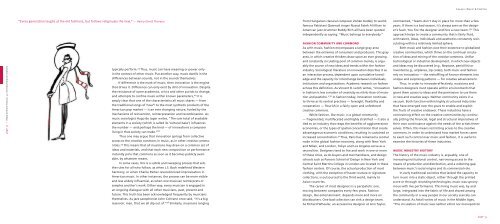Testimony of David Wolfe, Creative Director The ... - Public Knowledge
Testimony of David Wolfe, Creative Director The ... - Public Knowledge
Testimony of David Wolfe, Creative Director The ... - Public Knowledge
Create successful ePaper yourself
Turn your PDF publications into a flip-book with our unique Google optimized e-Paper software.
E s s a y s : M u s i c & F a s h i o n<br />
“Every generation laughs at the old fashions, but follows religiously the new.” — Henry <strong>David</strong> Thoreau<br />
from Hungarian classical composer Zoltán Kodály to world-<br />
commented, “Teams don’t stay in place for more than a few<br />
famous Pakistani Qawwali singer Nusrat Fateh Ali Khan to<br />
years. If there is a bad season, it’s always seen as the design-<br />
American jazz drummer Buddy Rich all have been quoted<br />
er’s fault. You fire the designer and hire a new team.” 32 This<br />
independently as saying: “Music belongs to everybody.”<br />
approach helps to create a community that is fairly fluid,<br />
fashion community and commons<br />
As with music, fashion encompasses a large gray area<br />
with talent, ideas, individuals and aesthetics constantly recirculating<br />
within a relatively limited sphere.<br />
Both music and fashion owe their existence to globalized<br />
between the extremes <strong>of</strong> consumers and producers. This gray<br />
creative communities, which thrive on the continual circula-<br />
area, in which creative thinkers draw upon an ever growing<br />
tion <strong>of</strong> ideas and mining <strong>of</strong> the creative commons. Unlike<br />
and constantly circulating pool <strong>of</strong> common memes, is argu-<br />
technological or industrial development, in which new objects<br />
page 52 | Ready to Share: Fashion & the Ownership <strong>of</strong> Creativity<br />
typically perform. 23 Thus, music can have meaning or power only<br />
in the context <strong>of</strong> other music. Put another way, music dwells in the<br />
differences between sounds, not in the sounds themselves.<br />
If difference is the mark <strong>of</strong> music, then innovation is the engine<br />
that drives it. Difference can only exist by dint <strong>of</strong> innovation. Despite<br />
the resistance <strong>of</strong> some academics, critics and other purists to change,<br />
and attempts to confine music within known parameters, 24 it is<br />
amply clear that one <strong>of</strong> the characteristics all music shares — from<br />
the traditional songs <strong>of</strong> Tuva 25 to the most synthetic products <strong>of</strong> the<br />
American pop market — is an ever changing nature, fueled by the<br />
mechanisms <strong>of</strong> reinvention, reinterpretation and recombination. As<br />
music sociologist Hugo de Jager writes, “<strong>The</strong> sum total <strong>of</strong> available<br />
elements in a society (which is called its ‘cultural base’) influences<br />
the number — and perhaps the kind — <strong>of</strong> innovations a composer<br />
living in that society can make.” 26<br />
Thus one may argue that innovation springs from collective<br />
access to the creative commons in music, as in other creative communities.<br />
27 This means that all musicians may draw on a common set <strong>of</strong><br />
ideas and materials, and that each new composition or performance<br />
instantly joins that commons as soon as it becomes publicly available,<br />
by whatever means.<br />
In some cases, this is a subtle and sweeping process that sets<br />
the rules for all who follow, as when J.S. Bach redefined Western<br />
harmony, or when Charlie Parker revolutionized improvisation in<br />
American music. In other instances, the process can be more visible<br />
and less widely influential, as when one musician reinterprets or<br />
samples another’s work. Either way, every musician is engaged in<br />
an ongoing dialogue with all other musicians, past, present and<br />
future. This truth has been acknowledged frequently by musicians<br />
themselves. As jazz saxophonist John Coltrane once said, “It’s a big<br />
reservoir, man, that we all dip out <strong>of</strong>.” 28 Similarly, musicians ranging<br />
ably the source <strong>of</strong> new ideas and trends within the fashion<br />
industry. Sociological literature on innovation describes it as<br />
an interactive process, dependent upon cumulative knowledge<br />
and the capacity for interchange between individuals,<br />
institutions and organizations. Academic research on fashion<br />
echoes this definition. As Vincent B. Leitch writes, “innovation<br />
in fashion is less a matter <strong>of</strong> creativity ex nihilo than <strong>of</strong> mutation<br />
and pastiche.” 30 In fashion today, innovation continues<br />
to thrive as its central practices — foresight, flexibility and<br />
cooperation — flourish in a fairly open and unfettered<br />
creative commons.<br />
While fashion, like music, is a global community<br />
— fragmented, multifaceted and highly stratified — it also is<br />
tied to an industry that reaps the benefits <strong>of</strong> agglomeration<br />
economies, or the types <strong>of</strong> spatial concentration that create<br />
advantageous economic conditions, resulting in sustained or<br />
increased concentration. 31 Thus, Paris has remained a central<br />
node in the global fashion economy, along with New York<br />
and Milan, and London, Tokyo and Los Angeles serve as a<br />
second tier. Designers tend to live and work in one or more<br />
<strong>of</strong> these cities, as do buyers and merchandisers, and design<br />
schools such as Parsons School <strong>of</strong> Design in New York and<br />
Central Saint Martins College in London are located in these<br />
fashion centers. Of course, the actual production <strong>of</strong> most<br />
clothing, with the exception <strong>of</strong> haute couture or signature<br />
collections, is outsourced to the third world, mainly to<br />
Asian countries.<br />
<strong>The</strong> career <strong>of</strong> most designers is a peripatetic one,<br />
moving between companies every few years. Fashion<br />
design, like entertainment, depends more and more on<br />
blockbusters. One bad collection can sink a design team.<br />
As Richard Wheeler, an accessories designer at Ann Taylor,<br />
and ideas may be discovered (e.g., Neptune, penicillin) or<br />
invented (e.g., airplanes, zip codes), both music and fashion<br />
rely on innovation — the reshuffling <strong>of</strong> known elements into<br />
unique and surprising patterns — for creative advancement.<br />
Thus, in order to innovate effectively, musicians and<br />
fashion designers must operate within environments that<br />
grant them access to ideas and the permission to use them<br />
in new and creative ways. Neither community exists in a<br />
vacuum. Both function within highly structured industries<br />
that have emerged over the years to enable and exploit<br />
the fruits <strong>of</strong> creative endeavor. <strong>The</strong>se industries have a<br />
constraining effect on the creative communities by continually<br />
pitting the financial, legal and structural imperatives <strong>of</strong><br />
their own continuance against the needs <strong>of</strong> the artists themselves.<br />
Often, this means restricting access to the creative<br />
commons. In order to understand how market forces came<br />
to exert such control over music and fashion, it is useful to<br />
examine the histories <strong>of</strong> these industries.<br />
music industry history<br />
<strong>The</strong> history <strong>of</strong> the music industry is, arguably, one <strong>of</strong><br />
increasing institutional control, narrowing access to the<br />
means <strong>of</strong> production and distribution, and a widening gap<br />
between music’s social origins and its commercial role.<br />
In early traditional societies that lacked the capacity to<br />
turn music into a static object, either through the printed<br />
score or through recording technologies, music was synonymous<br />
with live performance. This living music was, by and<br />
large, integrated into the fabric <strong>of</strong> life and shared among<br />
the community in a way people in our society scarcely can<br />
understand. As Attali writes <strong>of</strong> music in the Middle Ages,<br />
“<strong>The</strong> circulation <strong>of</strong> music was neither elitist nor monopolistic<br />
page 53





